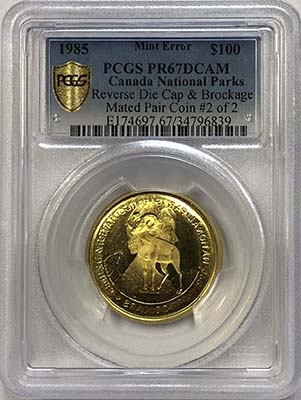Glossary
CategoriesBonded CoinsBroadstrikes Brockages Counterbrockages Die Adjustment Strikes Die Caps Die Trials Double Denomination Double/Multiple Strikes Dual Countries Dual Mint Marks Essay Trial Strikes Experimental Blanks Experimental Strikes Experimental Surface Feeder Finger Strikes Foreign Coins Struck on U.S. Planchets Galvanos Gold Die Trials Gold Errors Gold Off-Metals Hub Trials Indents Intentional Errors Martha Washington Test Pieces Mated Pairs Mules Multiple Errors Off-Centers Off-Metals Overstrikes Pattern Die Trials Pattern Errors Pattern Mules Plaster Models Platinum Errors Proof Errors SMS Mint Errors Specimens Spectacular Errors Struck Scrap Struck Thru Transitional Errors Two-Headed Coins Two-Tailed Coins Uncancelled Dies Uniface Die Trials Unique Coins |
  Mated PairsThe rarest mated pair type involves two die caps (obverse and reverse) where both dies were capped at the same time and both die caps are mated. This last type is extremely rare and there are only a few known examples of mated pairs involving an obverse die cap and reverse die cap. One of the most spectacular mated pairs involve two Barber Dimes, an obverse die cap mated to a reverse die cap and are unique. Mated pairs can also involve an off-metal where a smaller planchet or smaller struck coin was struck on top of a larger coin. This type is extremely rare. The most spectacular pair known is a double struck Franklin Half which was mated to a Lincoln Cent. The Lincoln Cent blank was on top of the obverse of the struck Franklin Half. This pair was then struck together. It is unique. Pictured above is a unique mated pair of the only known reverse die caps for any Canadian gold coin. Coin #1 is a Canadian Gold $100 Reverse Die Cap. The Royal Canadian Mint issued this coin in 1985. It is the $100 National Park Commemorative Coin. The obverse depicts Queen Elizabeth II and the reverse depicts a Rocky Mountain Bighorn sheep. After being struck, Coin #1 adhered to the reverse die and became a reverse die cap striking planchets that created a brockage on the reverse of each coin. The obverse design of this die cap expanded with each strike. As with any reverse die cap, the shape resembles a bottle cap with deep walls. This gold die cap struck a large number of coins as the diameter expanded. Coin #2 is also a Canadian Gold $100 Reverse Die Cap. After being struck, this coin adhered to the reverse die becoming a reverse die cap. It subsequently struck Coin #1 creating a brockage on the obverse of Coin #2, resulting in this phenomenal mated pair. As with any reverse die cap, the shape resembles a bottle cap. |



